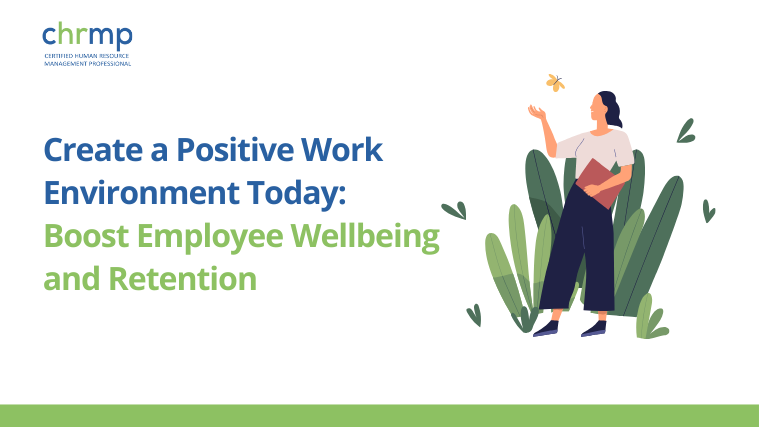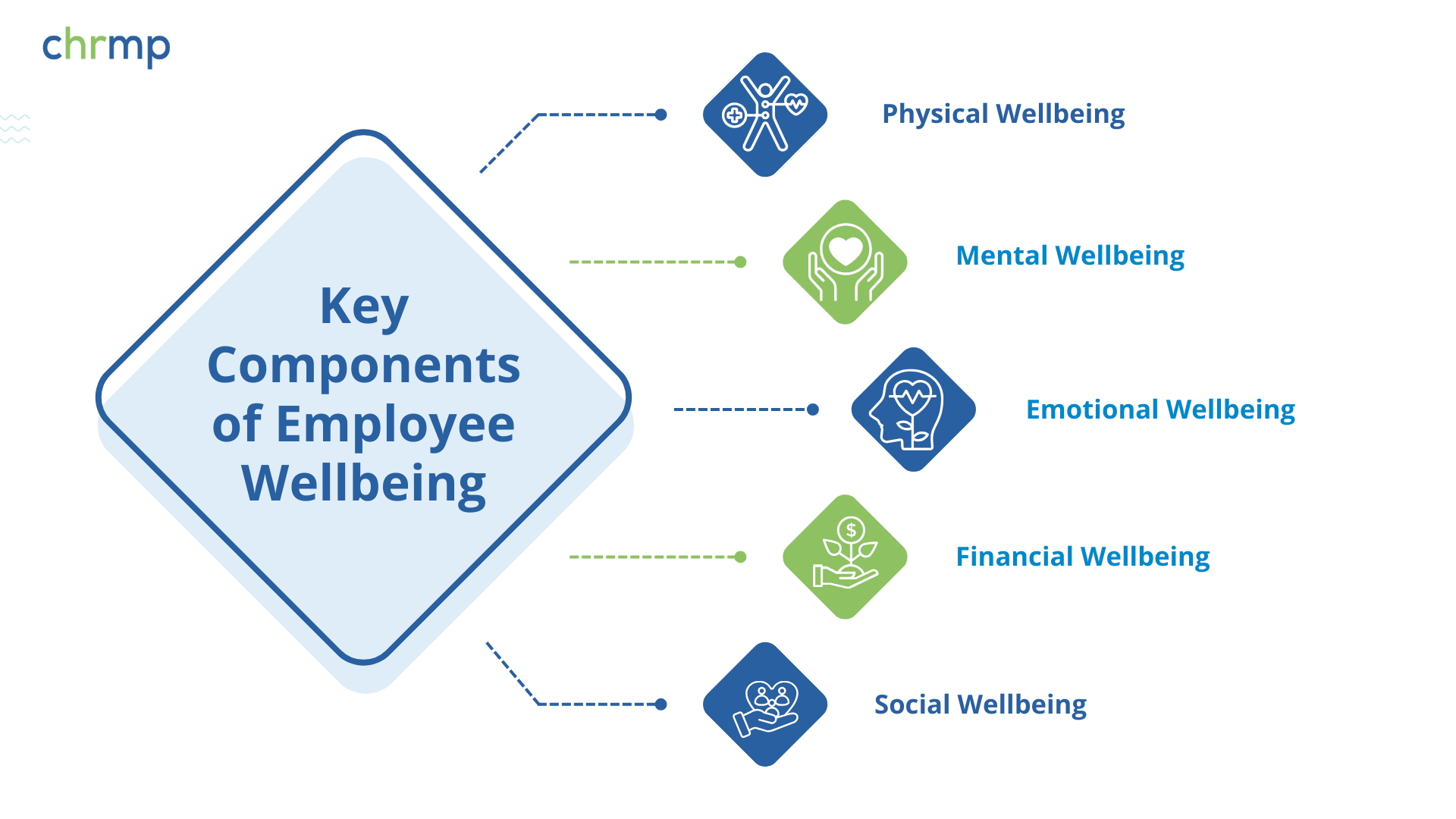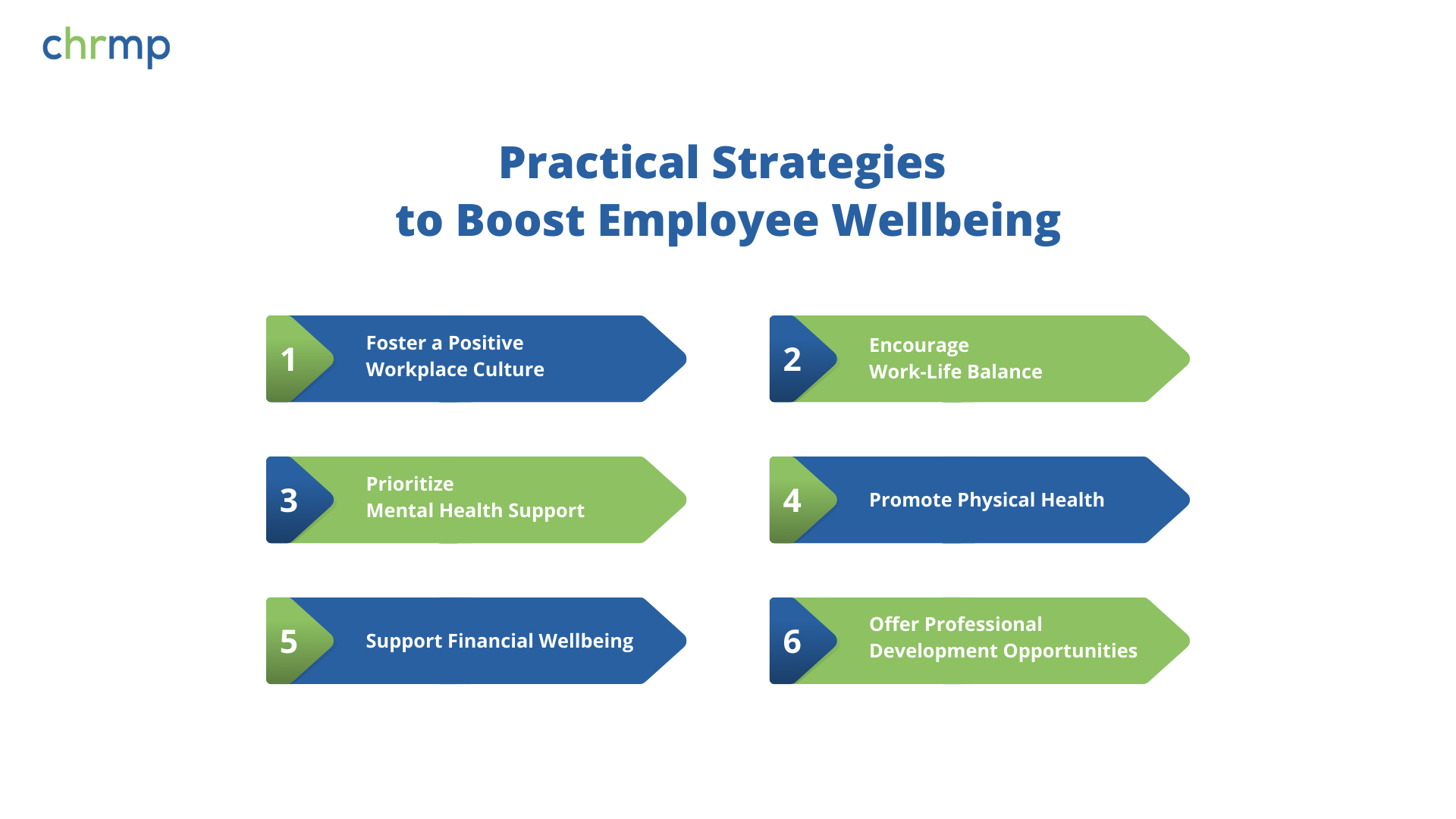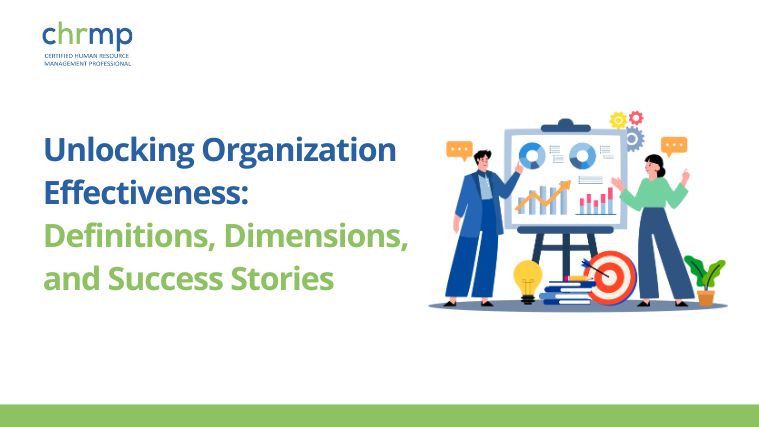In today’s rapidly evolving workplace, employee wellbeing has become a critical priority for businesses aiming to enhance performance, engagement, and retention. As remote work continues to blur the boundaries between personal and professional life, companies must recognize the increasing importance of promoting employee health and happiness. Doing so not only supports the overall welfare of their workforce but also drives productivity and fosters a positive company culture.
This blog will dive into the essential components of employee wellbeing, explore the benefits of prioritizing wellness in the workplace, and offer practical strategies to improve employee health, engagement, and retention.
What is Employee Wellbeing?
Employee wellbeing refers to the holistic health of an employee, encompassing their mental, physical, emotional, and financial wellbeing. In the workplace, wellbeing involves more than just providing health benefits—it’s about creating an environment that allows employees to thrive and reach their full potential.
Key Components of Employee Wellbeing
- Physical Wellbeing: This includes the physical health of employees, such as their ability to perform tasks effectively without being hindered by illness or injury. Access to healthcare, fitness programs, and proper ergonomics are vital.
- Mental Wellbeing: Mental health is crucial to overall wellbeing. Ensuring that employees are mentally healthy involves reducing workplace stress, providing access to mental health resources, and fostering a culture of open communication about mental health issues.
- Emotional Wellbeing: Emotional wellbeing refers to the ability to manage stress, build positive relationships, and maintain resilience in the face of challenges. Employers can support emotional wellbeing through positive reinforcement, employee recognition, and providing a supportive environment.
- Financial Wellbeing: Financial health plays a significant role in an employee’s overall wellbeing. Offering competitive salaries, financial planning resources, and benefits like retirement savings plans help alleviate financial stress.
- Social Wellbeing: Encouraging social connections at work can improve engagement, collaboration, and overall satisfaction. Positive workplace relationships contribute significantly to a person’s wellbeing.
Why Employee Wellbeing is Essential
Prioritizing employee wellbeing delivers long-term benefits for both employees and the organization. Here are the key reasons why it is essential to invest in employee wellbeing:
- Increased Productivity: Healthy, engaged employees are more focused and productive, which positively impacts business outcomes.
- Reduced Absenteeism: By promoting physical and mental health, organizations can reduce sick days and absenteeism, leading to more consistent performance and lower costs.
- Higher Employee Retention: Employees who feel valued and supported are more likely to stay with their current employer, reducing turnover costs.
- Improved Company Culture: A focus on wellbeing fosters a positive, collaborative, and inclusive workplace culture where employees feel respected and appreciated.
- Lower Healthcare Costs: Healthier employees mean lower healthcare expenses for both employees and employers. By proactively addressing employee wellness, companies can reduce long-term healthcare costs.
- Enhanced Employee Engagement: Employees who feel supported in their health and wellbeing are more likely to be engaged, loyal, and committed to their organization’s goals.
The Benefits of Wellbeing in the Workplace
The benefits of wellbeing in the workplace go far beyond improving individual employee health. When companies prioritize wellness in the workplace, they see significant improvements in key business areas:
- Increased Job Satisfaction: Employees who feel that their wellbeing is a priority are happier, more satisfied with their jobs, and more likely to stay with the company.
- Boost in Creativity and Innovation: Employees with high levels of wellbeing are more engaged and have the mental clarity to focus on creative problem-solving, driving innovation.
- Positive Employer Branding: Companies that invest in employee wellbeing are viewed more favorably by job seekers and current employees alike. A positive reputation for caring about staff wellness can make a company more attractive to top talent.
- Higher Employee Advocacy: Employees who feel valued and supported are more likely to speak positively about their employer, increasing word-of-mouth referrals and boosting the company’s brand image.
- Lower Turnover Rates: Employee wellbeing initiatives lead to lower turnover rates, as staff members are more likely to remain with an employer that invests in their health and happiness.
Practical Strategies to Boost Employee Wellbeing
To build a workplace that prioritizes employee wellbeing, it’s essential to implement strategies that support all aspects of health and wellness. Here are some proven ways to create a healthier, happier, and more productive work environment:
- Foster a Positive Workplace Culture
A supportive and inclusive culture is key to employee wellbeing. Employees should feel connected to the organization’s mission and values, as well as to their colleagues and leaders.- How to Implement: Create opportunities for open communication, celebrate achievements, and provide regular feedback. Encourage team-building activities and initiatives that foster collaboration and mutual respect.
- Encourage Work-Life Balance
Work-life balance is a critical factor in reducing burnout, stress, and turnover. Employees need time to recharge and attend to their personal lives without feeling overwhelmed by work responsibilities.- How to Implement: Offer flexible working hours, remote work options, and ensure employees have sufficient time off. Encourage employees to take regular breaks and vacations to prevent burnout.
- Prioritize Mental Health Support
Mental health is a vital part of overall wellbeing, yet many employees struggle with stress, anxiety, and other mental health issues. Organizations that support mental health see higher levels of engagement and satisfaction.- How to Implement: Offer access to mental health services such as Employee Assistance Programs (EAPs), counseling, and mindfulness resources. Train managers to recognize the signs of mental health struggles and provide support when needed.
- Promote Physical Health
Physical health is foundational to wellbeing. When employees are healthy and active, they are more energized, focused, and able to perform at their best.- How to Implement: Provide wellness programs, on-site fitness classes, or gym memberships. Encourage healthy lifestyle choices by offering nutritious snacks in the office and organizing group fitness challenges.
- Support Financial Wellbeing
Financial stress can significantly affect an employee’s mental and emotional health. Supporting financial wellness not only helps employees feel secure but also boosts productivity and morale.- How to Implement: Provide financial planning resources, offer competitive salaries, and consider benefits like retirement savings plans, educational stipends, and financial counseling.
- Offer Professional Development Opportunities
Professional growth contributes to job satisfaction and engagement. Employees want to feel that they are progressing in their careers and developing new skills.- How to Implement: Invest in training and development programs, mentorship opportunities, and career advancement pathways. Encourage employees to pursue learning and development goals that align with their career aspirations.
Employee Health and Wellbeing: How to Measure Success
To ensure that employee wellbeing initiatives are effective, it’s essential to measure their impact regularly. Here are several metrics you can track:
- Employee Engagement Surveys: Engagement surveys help assess how supported employees feel in terms of wellbeing, as well as their overall satisfaction with their work environment.
- Absenteeism Rates: Track absenteeism rates to identify whether wellbeing programs are reducing sick days and improving attendance.
- Turnover Rates: Measure employee turnover to determine whether wellbeing initiatives are improving retention rates and reducing attrition.
- Productivity Metrics: Analyze employee productivity to see how improvements in wellbeing impact overall performance and output.
- Employee Feedback: Encourage employees to share feedback on wellbeing programs to help you identify areas of improvement and new opportunities to support their health.
Real-World Examples of Successful Wellbeing Initiatives
Many leading organizations have set an example by prioritizing employee wellness and reaping the rewards of improved retention, engagement, and productivity:
- Google: Google’s comprehensive wellbeing programs include access to on-site fitness centers, healthy meals, and mindfulness courses. Their focus on both physical and mental health has made them one of the most sought-after employers globally.
- Salesforce: Salesforce places a strong emphasis on employee mental health by offering a mindfulness program, mental health days, and stress management resources to support their staff.
- Zappos: Known for its commitment to employee satisfaction, Zappos offers life coaching and personal development programs to promote holistic wellbeing for both personal and professional growth.
Do’s and Don’ts for Promoting Employee Wellbeing
Do’s:
- Encourage Flexibility: Provide flexible work options to help employees manage personal and professional responsibilities effectively.
- Offer Comprehensive Benefits: Ensure wellness programs include mental, physical, and financial health resources tailored to employees’ diverse needs.
- Solicit Feedback: Regularly seek input from employees to continuously improve and evolve your wellness initiatives.
Don’ts:
- Ignore Mental Health: Failing to address mental health can lead to burnout and disengagement. Ensure that mental health resources are widely available and accessible.
- Implement a One-Size-Fits-All Approach: Tailor wellness initiatives to fit the unique needs and preferences of your workforce.
- Neglect Communication: Keep employees informed about the wellness programs and benefits available to them, and ensure that leaders actively promote and participate in these programs.
Conclusion
Prioritizing employee wellbeing is no longer optional in today’s business environment—it is essential for cultivating a positive work culture, improving retention, and driving organizational success. By offering flexible work arrangements, promoting physical and mental health, and fostering a supportive workplace, businesses can create environments where employees thrive.
Investing in wellbeing in the workplace not only boosts employee satisfaction and productivity but also enhances company culture and retention rates. The time to focus on employee health and wellness is now, as it directly impacts both individual performance and overall business outcomes.









